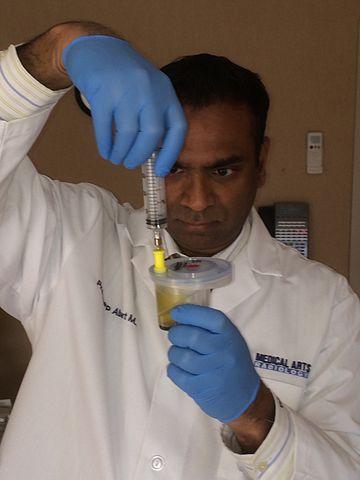Ah, the mighty platelet. Once a neglected blood component, today it is the basis of an entirely new medical “specialty,” regenerative medicine, although market might be a better word choice.
The use of blood products in roles other than transfusion began almost a half-century ago when fibrinogen was used as a type of glue, to put tissue together. Platelets, neither a cell, like the red or white blood cell, nor a metabolite, like fibrinogen, is a cell fragment (no nucleus). It is deeply involved in tissue repair, helping to form clots to fix a leaky blood vessel and containing a number of growth factors that signal and stimulate cell proliferation and remodeling – enhancing healing. When an agent that may promote healing meets tissue that is, often, difficult to heal, well, this is either a match made in scientific or marketing heaven.
A $45 million market in 2009, Platelet Rich Plasma or PRP sales quadrupled by 2016 and growth is estimated to continue at about 12 to 13% annually. The indications for the use of platelets initially for orthopedic problems was extended to the pain for those same orthopedic issues, to wound healing in general and even hair restoration. Platelets can be used by themselves or in conjunction with other medications and procedures. For physicians looking for a procedure, PRP is about as good as it gets.
From a medical perspective, it is a natural product, coming from the patient themselves, so little worry about allergic reactions or harmful side effects. As to the pesky issue of whether it is a cure-all or snake-oil, that depends on what you read and what was studied. One meta-analysis of 109 published studies found that more than half were literature reviews and meta-analysis, in the words of the author, “there is more talk than real attempts to understand how this treatment could be useful in the clinical practice.”
Does PRP work?
The first problem in finding value in PRP is that like the blind men and the elephant; everyone has a different definition of what PRP means. Creating that rich plasma begins by taking about 2 ounces of your blood and spinning it in a centrifuge that separates components by their weight. The red blood cells are at the bottom of the tube, plasma with very few platelets is on the top, and in between, there is a “buffy coat,” where the platelet rich plasma is to be found. PRP can mean just pure platelets, or it may include white blood cells and/or fibrin, the product of fibrinogen. So overall there can be four different forms of PRP based on how long and fast the blood spins in the centrifuge. But once made, in less than an hour in the doctor’s office, they are “activated” causing them to release their signals and growth factors and injected into the problematic body part.
As a result, studies are frequently comparing apples to oranges or some other metaphorical fruit. From a marketing view, the act of concentrating the platelets and knowing how and where to inject them results in charges ranging from $500 to upwards to $2,000 [1] with insurance covering little of the cost. So, we are talking cash, check or credit card. Medicare does not include these treatments, and to be honest, Medicare covers nearly everything that shows efficacy.
The second concern in finding PRP’s value is where this aid to healing is applied. Bones, cartilage, and tendons have poor blood supplies compared to other tissue. As a result, all the cellular goodies necessary for healing transported through the blood have difficulty getting to these tissues, and healing is slowed. The same is true for what vascular surgeons would describe as “non-healing” wounds of the legs, where again the blood supply is compromised as is the healing. Another purported indication for PRP is in the treatment of pain associated with those orthopedic injuries, which do hurt and do not always respond to non-steroidal or steroidal anti-inflammatory drugs (Opioids, of course, are less frequently indicated and in today’s cultural climate banished)
Let the patient beware
An international orthopedic review suggests “PRP may provide some benefit in patients who have knee osteoarthritis and lateral epicondylitis” - often referred to as “tennis elbow.” For all the other orthopedic indications results were inconsistent. They ended by recommending that the evidence-based clinician be “weary,” although I am pretty sure that they meant wary, in applying PRP to their practice. The American Association of Orthopedic Surgeons felt that the use in knee osteoarthritis was “inconclusive,” and there had been “some success” in treating lateral epicondylitis. Neither a real recommendation. The Cochrane group found “the available evidence is insufficient to support the use” of PRP for orthopedic soft tissue injury, and as for wound healing “PRP may improve the healing of foot ulcers associated with diabetes, but this conclusion is based on low-quality evidence…”
Does PRP help? The bottom line is that we can point to the articles of our choice, but we do not know. Despite its theoretical biologic plausibility, it has yet to demonstrate its practical value in large populations.
[1] Not all of those charges return to the physician. Every company in the regenerative medicine business of PRP retrieval and application sells its own brand name “harvesting kit” at prices from $175 to over $1,000.
Sources: Classification of platelet concentrates: from pure platelet-rich plasma (P-PRP) to leucocyte- and platelet-rich fibrin (L-PRF) Cell DOI: 10.1016/j.tibtech.2008.11.009
PRP: more words than facts Knee Surgery Sports Traumatology Arthroscopy DOI:10.1007/s00167-012-2136-x
An evidence-based evaluation on the use of platelet-rich plasma in orthopedics – a review of the literature SICOT-J DOI: 10.1051/sicotj/2017036
Platelet-rich therapies for musculoskeletal soft tissue injuries Cochrane Library
Autologous platelet-rich plasma for treating chronic wounds Cochrane Library




